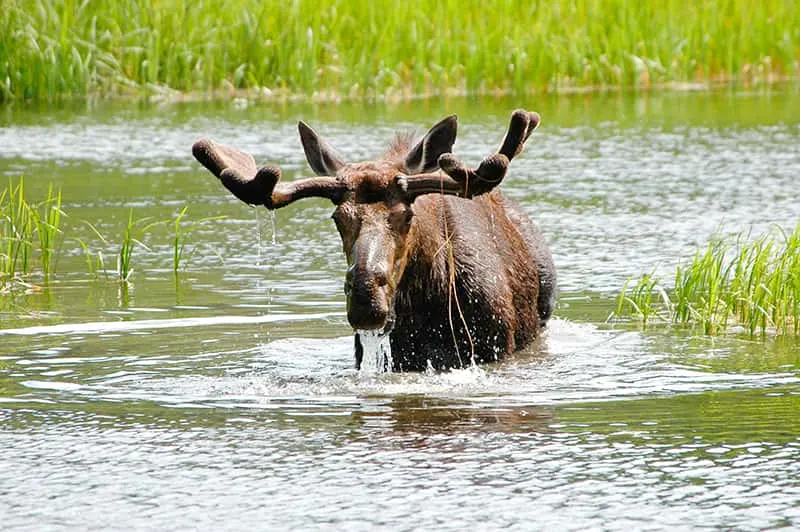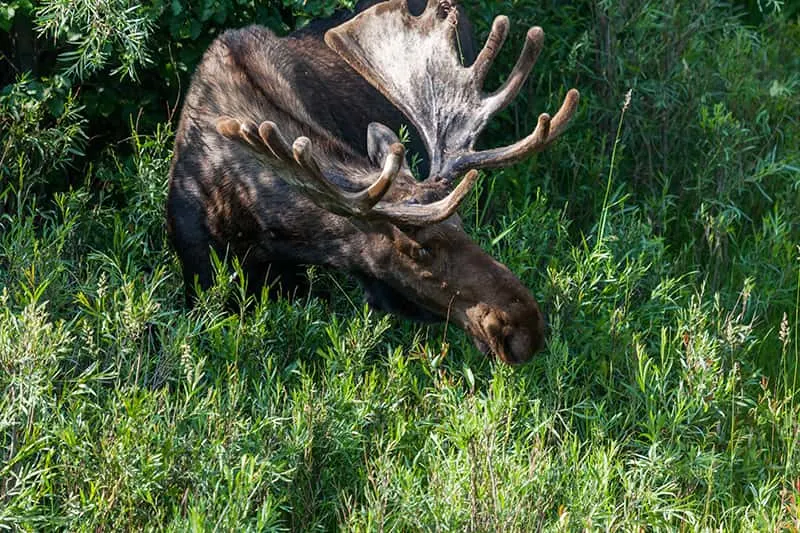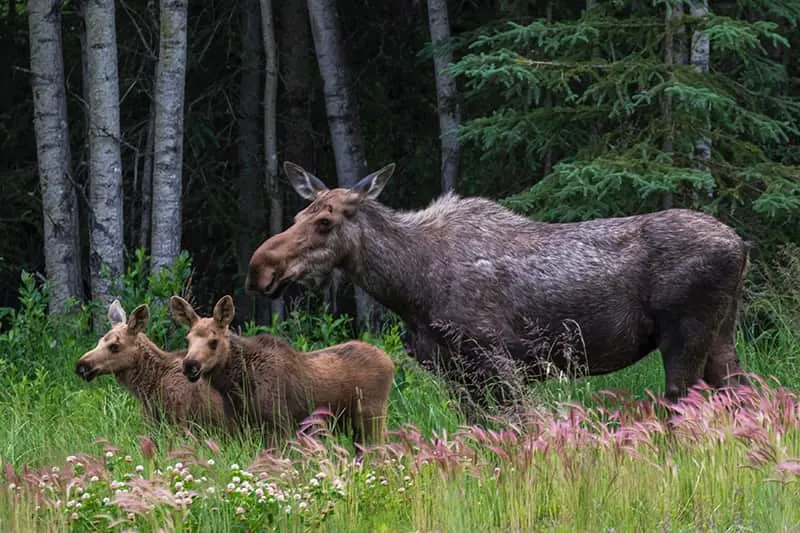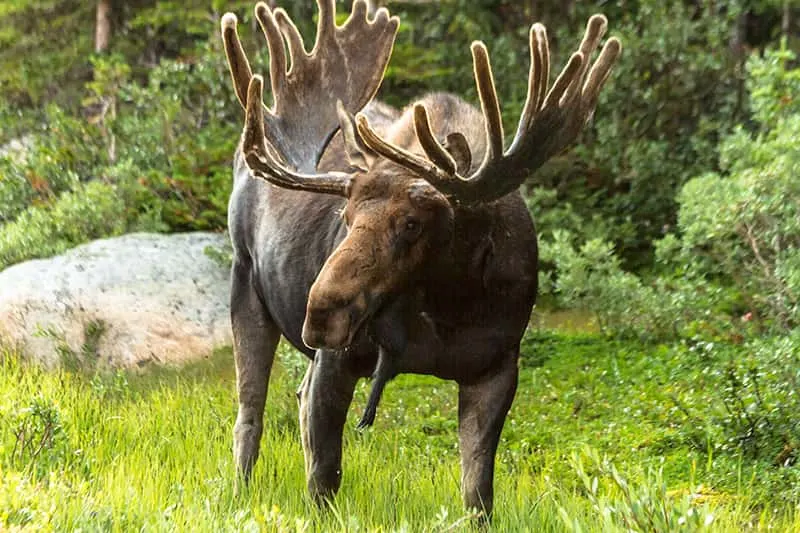Want to learn some moose facts for kids? You’ll find them in this post. We’ll talk about their physical description, diet, offspring, and more!

Moose are native to North America. Moose are called “Eurasian elk” in Europe and Asia.
There are four subspecies of moose in North America.
These are:
Eastern moose
Western moose
Alaska moose
Shiras moose
In this article, we’ll look at what the four moose species have in common.
Physical Description
Moose colors range from light brown to light black. Moose have large heads with long snouts, large nostrils, and small eyes. Their ears are medium-length and erect. Only male moose have antlers. The antlers are in the shape of a hand. They are thin, wide, and broad, with little upward-pointing spikes.
Moose have a piece of skin that hangs on their throats called “dewlaps”. Because of their large shoulders, their massive bodies looked humped in appearance. They have four thin legs, hooved feet, and short tails.
Moose weigh anywhere from four hundred and forty pounds to fifteen hundred pounds. They range from almost eight feet to ten feet in length. Males are quite a bit heavier than females and just a little longer.
Habitat
Moose in North America range from Alaska and through the Rocky Mountains to Colorado. Their range extends east to Newfoundland and south to New Hampshire. Moose can also be found in northern Wisconsin and North Dakota.
Moose are found in habitats that get snow in winter and have lots of water available in summer. These are usually woodland areas with swamps, streams, lakes, and ponds.

Habits
Moose are solitary creatures that are most active at dawn and dusk. They will also eat during the day or night if they are hungry.
Moose tolerate freezing temperatures because they have thick skin and fur. Moose don't like temperatures above sixty degrees Fahrenheit. As a result, moose behave differently in warm weather than in cold weather.
Moose wade and swim in hot weather to stay cool and eat aquatic plants. Moose eat different things in the winter. They also move less in the winter and avoid deep snow.
Diet
Moose are herbivores. They eat vegetation of all kinds. Their diet varies based on what vegetation is available. Their diet changes with each season.
In the spring, moose mainly eat new, growing vegetation. Tall grass, flowers, and fruits are examples of a moose’s spring diet.
During the summer, moose continue to eat tall grasses and other growing plants. Aquatic vegetation such as reeds and water lilies begin to make up a large part of their diet. They also eat vegetables and fruit they find on farms and gardens.

In the fall, moose continue to eat growing grass and plants that they find. They also begin eating shrubs and tree roots.
In winter, moose continue to eat shrubs, but trees replace plants as the main food source. Moose feed on the branches, roots, and bark of willow, aspen, and birch trees.
Moose supplement their diet with mushrooms and nuts. Moose need salt regularly, which they get from tree root soil or other places.
Offspring
Moose cows give birth every year after they turn three years old. Moose cows are pregnant for almost eight months. A moose cow gives birth to one or two calves. Typically, a cow will give birth to twins every three years.

Calves weigh about thirty pounds when they are born. They are born helpless but mature very fast. Calves can swim and outrun humans when they are only a few days old. They start trying out different vegetation within a couple of weeks.
By the age of two months, calves are eating vegetation and nursing very little. By five months old, they weigh about three hundred pounds, have stopped nursing, and just eat plants.
Calves become independent at around one year of age.
Classification/Taxonomy
Kingdom: Animalia
Phylum: Chordata
Class: Mammalia
Order: Artiodactyla
Family: Cervidae
Genus: Alces
History
More than a half-million years ago, moose originated in Europe. They then migrated across Europe, Siberia, and to North America.
Predators
Moose have a few natural predators. Bears and wolves are the main predators that prey on moose. Wolverines, cougars, and orcas all prey on moose, but less frequently.
Lifespan
Moose have been known to live twenty years in the wild, but they typically live about half that age. The oldest moose in captivity lived to be eighteen years old.

What Sound Does a Moose Make?
Want to hear what a moose sounds like? Click on this player.
25+ Unusual Moose Facts for Kids
- Moose are the tallest and heaviest of the deer family.
- The scientific name of a moose is Alces alces.
- The name “Moose” comes from the Algonquin word “Moswa”, which means “twig-eater”.
- Moose can sleep while standing up.
- Moose don’t see as well as people do.
- Moose have a great sense of smell and hearing.
- Moose swim six miles per hour, which is three times as fast as the average person.
- Moose fur has hollow hairs that provide insulation in the cold and buoyancy in the water.
- Moose do not hibernate.
- Moose in some areas migrate from a summer habitat to a different habitat for winter.
- The biggest moose on record was 7 1/2 feet tall and weighed 1808 pounds.
- Moose can dive as deep as 20 feet underwater to reach plants to eat.
- Moose can remain underwater for 50 seconds.
- A moose can run 35 miles per hour.
- Moose may be aggressive toward people if cows are protecting their young or they feel threatened.
- Moose close their nostrils when swimming underwater.
- Moose eat more in the spring to replenish the stored fat they lost over the winter.
- A male moose is called a bull, a female moose is called a cow, and a baby moose is called a calf.
- The name of the breeding season for moose is called “rutting,” when bull moose often fight for females.
- Moose do not mate for life, but typically have one mate per breeding season.
- The moose’s ancestor was a “stag-moose” who lived during the Ice Age.
- Moose antlers are called “palmate” because they resemble an open hand with a visible palm.
- Moose antlers are made of bone and grow out of the skull.
- Moose shed their antlers every year and regrow new ones.
- Moose antlers can grow up to 6 feet across and weigh as much as 18 pounds.
- Moose use different parts of their habitat in the summer than they do in the winter.
- In the summer, moose frequently swim across lakes in search of food.
- Moose are picky eaters and choose habitats where their favorite foods are available.
- Moose require between 40 and 70 pounds of food every day.
We hope you had a great time learning all about moose. Did you learn anything new? Let us know any other facts you know about them. We can’t wait to hear from you!
